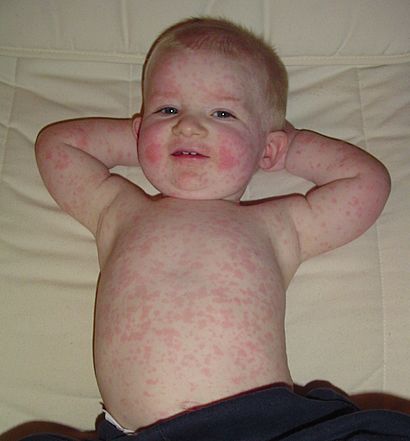Fifth disease facts for kids
Fifth disease, also known as erythema infectiosum, is a common illness that mostly affects children. It's caused by a tiny germ called parvovirus B19. This disease is known for causing a bright red rash, especially on the cheeks, which is why it's sometimes called "slapped cheek syndrome."
The name "fifth disease" comes from a historical list of common childhood rashes. It was the fifth one on that list! Other diseases on the list include measles (first), scarlet fever (second), and rubella (third).
Contents
What are the Signs?
Fifth disease often starts with symptoms that feel like a mild cold. You might have a low-grade fever, a headache, or a runny nose. These early symptoms usually go away after a few days.
The Rash Appears
A few days later, the famous rash shows up. It's usually a very bright red rash on the cheeks. This can make it look like someone has been slapped! Sometimes, the rash can spread a little over the nose or around the mouth.
Besides the red cheeks, many kids also get a lacy, pinkish-red rash on other parts of their body. This rash often appears on the upper arms, chest, and legs. The rash usually lasts for a few days, but it can sometimes stick around for several weeks. It might feel a little itchy. Once the rash appears, a person is usually no longer able to spread the virus to others.
Symptoms in Older Kids and Adults
Teenagers and adults can also get fifth disease. For them, the rash might not be as noticeable. Instead, they might feel pain and swelling in their joints, similar to arthritis. This can make it hard to walk or bend joints like wrists, knees, ankles, fingers, and shoulders. These joint pains usually go away on their own.
How it Spreads
Fifth disease mainly spreads through tiny drops from a person's nose or mouth, like when they cough or sneeze. It can also spread through contact with infected blood, but this is less common.
Incubation Period
After someone gets infected, it usually takes about 4 to 21 days for symptoms to appear. This time is called the incubation period. People are most likely to spread the virus before they even know they have it, which is before the rash appears.
Who is at Risk?
Because it spreads easily, fifth disease often goes around in places where kids are close together. This includes schools, daycares, and preschools. Teachers and parents are also more likely to be exposed to the virus. Once the rash shows up, the risk of spreading the disease is very low. So, people with the rash usually don't need to stay home from school or work.
Treatment
There isn't a specific medicine to cure fifth disease. The body's immune system usually fights off the virus on its own. Treatment mainly focuses on making the person feel more comfortable.
Managing Symptoms
If you have a fever, medicines that reduce fever, like acetaminophen, can help. The rash usually doesn't itch much, but it can sometimes feel a little sore. Most people recover completely without any special treatment.
Who Gets It?
Anyone can get fifth disease, but it's most common in children between 5 and 15 years old. By the time people become adults, about half of them have already had fifth disease at some point. This means their immune system has learned to fight off the virus.
No Vaccine Yet
There isn't a vaccine available to prevent human parvovirus B19, the virus that causes fifth disease. Scientists have been working on developing one.
History of the Name
The name "fifth disease" comes from how doctors used to classify common childhood rashes. It was the fifth one on their list of six main skin rashes, also known as exanthems. Here's how they were listed:
- Measles (first)
- Scarlet fever (second)
- Rubella (third)
- Dukes' disease (fourth, though this one is not widely recognized today)
- Fifth disease (erythema infectiosum)
- Roseola (sixth)
See also
 In Spanish: Eritema infeccioso para niños
In Spanish: Eritema infeccioso para niños


